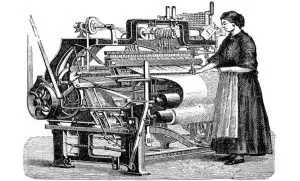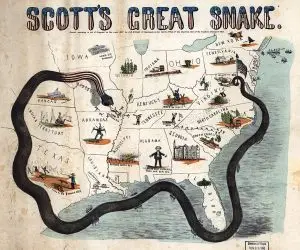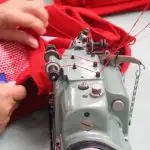The Birth of American Textiles: Samuel Slater and the Cotton Gin
In the late 1700s, the textile industry began to take off in England, and many Americans wished to see the same development in the United States. However, English law made it illegal to carry loom designs out of England. Samuel Slater circumvented this law by emigrating to the United States and bringing in his head the knowledge of power looms to America in 1789. In 1790, Slater’s knowledge helped Moses Brown build the first water-powered spinning textile mill in America. After Eli Whitney invented the cotton gin, a device that sped up the process of sorting the cotton seed from cotton fiber, in 1793, the cotton textile industry grew rapidly in America.
The Lowell System and the Start of Industrialization
Within several years, Francis Cabot Lowell, an American merchant, helped to establish the first textile factory in the United States. Impressed by the British textile mills, he established his own and formed the Boston Manufacturing Company in 1813 with several partners.

Growth of the Lowell Mill Town and Industry Dominance
When Lowell died of an illness in 1817, the investors in his company received dividends, which they used to create a larger mill town in 1822.2 They named the Massachusetts town Lowell in honor of Francis Cabot Lowell. Thanks to Lowell, the majority of businesses by 1832 were related to the textile industry.3
The Rise of “King Cotton” and Southern Dominance
Cotton became known as “King Cotton” in the South, and the Southern United States became the chief cotton supplier in the 1800s. In 1860 alone, over 60 percent of American exports was raw cotton.4 For cotton that was produced, the Boston Manufacturing Company was responsible for one-fifth of such production by the 1850s.5 By 1870, 2,400 woolen mills and hundreds of cotton mills permeated the United States.6
 The Civil War and Cotton as a Strategic Weapon
The Civil War and Cotton as a Strategic Weapon
War often drove the textile industry. In the case of the North Carolina textile industry, which was representative of the nation as a whole, the advent of the Civil War prompted a switch from yarn spinning to developing materials for the war effort.7 Cotton during the Civil War was an interesting bargaining chip. The South believed that their dominance of the cotton market would force European powers to recognize their claims to legitimacy. The textile industry, particularly in the areas around Liverpool, played a major role in the British economy and was dependent on American cotton. The North knew that the South’s ability to finance the war was dependent on it’s ability to export it’s cotton. The natural solution to this problem was to blockade Confederate ports. The Confederacy though had miscalculated and the British preferred to suffer the consequences of a cotton shortage and subsequent temporary collapse of it’s textile industry rather than choose sides in the war.
World War I and the Shift in Textile Leadership
Likewise, World War I brought an increased demand for American-made textile goods, specifically for blankets and military uniforms. Due to World War I, the textile industry in North Carolina in particular grew substantially, and, by 1923, North Carolina had surpassed Massachusetts as the leading textile-producing state in America based on value of product.8
Peak and Decline of American Textile Manufacturing
After World War I, textiles continued to play an important role in America’s industrial system, as they had since the early 1800s. In fact, the textile industry dominated the South, as employment in the textile industry peaked in June 1948 with 1.3 million jobs.9 North Carolina held the record with 40% of its jobs in textile and apparel manufacturing in 1940.10 In the 1960s, American textile companies produced 95% of bedding and clothing in the United States.11 But the American textile industry began to slow down in the late 1990s. Roughly 650 textile plants closed between 1997 and 2009, and North Carolina only had 1.1% of jobs in the textile industry in 2013.12 Most of American clothing is produced overseas with only 2-3% produced in the United States.13
A Modern Resurgence: The Carolinas and the Future of Textiles
Even so, the American textile industry has seen a resurgence in the states, especially in the Carolinas. Beginning in the early 2010s, China began to outsource jobs in the textile industry to the United States. Many even called it “just the beginning of a textile resurgence that will revitalize” the Carolinas.14 Today, the American textile industry is the fourth largest exporter of textile products in the world.15 In 2017, apparel, fiber, and textile exports were $28.6 billion.16 A world leader in textile research and development, the United States textile industry is particularly focused on next generation textile materials, especially for the U.S. military.17 As A. Blanton Godfrey, dean of the College of Textiles at North Carolina State University, noted, “But if Norma Rae [a character in a 1979 movie about a textile worker who campaigns an organizing push for unions] wants to sit at a computer terminal and program the robot, that’s different.”18 Godfrey is right: the textile industry has come a long way in the past 220 years from the first American water-powered spinning textile mill in 1790.
1 https://firstindustrialrevolution.weebly.com/the-textile-industry.html
2 http://historyofmassachusetts.org/massachusetts-industrial-revolution/
3 https://firstindustrialrevolution.weebly.com/the-textile-industry.html
4 The Vital Few: The Entrepreneur and American Economic Progress, by Jonathan Hughes
5 http://historyofmassachusetts.org/massachusetts-industrial-revolution/
6 https://mostateparks.com/page/55168/textile-mills-and-daily-life-america
7 https://www.ncpedia.org/textiles-part-2-rise-north-carolina
8 https://www.ncpedia.org/textiles-part-2-rise-north-carolina
9 https://www.usatoday.com/story/news/nation/2014/02/05/stateline-textile-industry-south/5223287/
10 https://www.usatoday.com/story/news/nation/2014/02/05/stateline-textile-industry-south/5223287/
11 https://www.cnbc.com/2013/09/23/inside-made-in-the-usa-showcasing-skilled-garment-workers.html
12 https://www.usatoday.com/story/news/nation/2014/02/05/stateline-textile-industry-south/5223287/
13 https://www.cnbc.com/2013/09/23/inside-made-in-the-usa-showcasing-skilled-garment-workers.html
14 http://exclusive.multibriefs.com/content/chinese-outsourcing-may-lead-to-textile-resurgence-in-
carolinas/manufacturing
15 http://www.ncto.org/facts-figures/us-textile-industry/
16 http://www.ncto.org/facts-figures/us-textile-industry/
17 http://www.ncto.org/facts-figures/us-textile-industry/
18 https://www.usatoday.com/story/news/nation/2014/02/05/stateline-textile-industry-south/5223287/

 The Civil War and Cotton as a Strategic Weapon
The Civil War and Cotton as a Strategic Weapon

